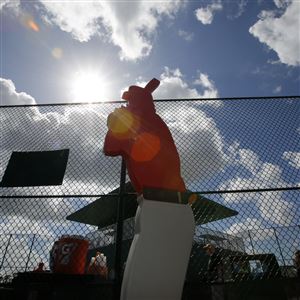In a windmill of emotion, Evgeni Malkin kicked his leg and pumped his fist, with a celebration big enough for the playoff-like atmosphere at PPG Paints Arena.
The Rangers and Penguins had been gridlocked in a tight-checking, staring contest for 45-plus minutes. During the goalie duel, Pittsburgh’s Tristan Jarry proved why he was named an NHL All-Star and New York’s Igor Shesterkin showed why he’s a leading candidate for the Vezina Trophy.
On an afternoon when the Penguins needed a difference maker, they found it on the power play to capture the 1-0 victory.
The play began when Kris Letang used his backhand to hold the puck in at the blue line. As he played it down the boards, the Rangers’ high-pressure kill converged on Sidney Crosby in the corner. The captain made a nifty, backhanded pass into the soft spot in the middle of the ice for Bryan Rust. He did the rest, finding Malkin all alone in his classic one-timer spot.
“The Rangers came out with a lot of pressure and with numbers in that corner,” Penguins coach Mike Sullivan said. “That was something that we knew was going to happen. They're a very aggressive kill. It's tough to beat their pressure. You have to support the puck really well. You’ve got to win puck battles.”
The goal was noteworthy for a number of reasons.
It marked Malkin’s 75th career game-winning goal, surpassing Mario Lemieux for second on the franchise’s all-time list. He now trails only Jaromir Jagr (78) for most game-winning goals in team history.
Beyond that, let’s dig deeper on the power play. During the past six games, the Penguins power play production dipped. They had converted on just 4-of-22 opportunities entering Saturday. More recently, the look and feel of the power play appeared out of sync. This week, the club spent significant portions of a number of practices focusing on special teams. The extra work paid off.
It was fitting that Malkin was the one who cracked through, too. Since Malkin returned from the lineup on Jan. 11, the Penguins have converted 19-of-67 opportunities. That’s a blistering 28.4% rate, the second-best in the NHL during that span.
“[Malkin] adds a certain level of unpredictability because Geno is so instinctive and he's able to do things with the puck that most guys can't,” Sullivan said. “I think that's what makes him the generational talent that he is.”
Malkin’s presence on the power play seems to have a ripple effect. He is, after all, the one who provided the primary assist on the Crosby’s 500th goal. Letang also seems to be benefiting, perhaps more than anyone else. With Malkin able to rotate to the point position, Letang has been freed up to assume a flank position, where he’s been uncorking more right-handed slappers.
“[Malkin] is just another threat that our opponents have to pay attention to,” Sullivan said. “If he's not getting an opportunity himself, if they're trying to take him away, it usually opens up something else for someone else on the ice … It makes it hard for teams to scout us.”
Pettersson at the point
Speaking of special teams, the Penguins made an interesting tweak to the second unit.
John Marino, who typically runs things from the point, was replaced by Marcus Pettersson. This was a somewhat surprising decision, especially considering Pettersson was more or less benched for parts of Thursday’s 6-1 loss after committing a few miscues.
Sullivan said one reason for the change was to manage Marino’s minutes. He’s become a penalty-killing mainstay this season and is also utilized often as a top-four defenseman. However, the coach said it goes a bit beyond that.
“I also think, at least it's my hope, that it will help Marcus' confidence a little bit just to get him to get them involved offensively,” Sullivan said. “Hopefully that will help his overall 5-on-5 game, as well.”
Friedman’s analytics off the charts
Mike Matheson’s upper-body injury opened the door for seldom-used defenseman Mark Friedman. For the first time since Jan. 8, he stepped into the lineup, skating on the third pair alongside Chad Ruhwedel.
Friedman logged 12:11 of ice time and his analytics were off the charts. When Friedman was on the ice, the Penguins created 98% of the expected goals, according to Natural Stat Trick.
Let’s put it in simpler terms. The Penguins attempted 14 shots when Friedman was on the ice and allowed just one. Pittsburgh also created six scoring chances, including three high-danger, when Friedman was on the ice and didn’t allow one.
“He's a real mobile guy,” Sullivan said. “So he uses his skating ability to win pucks and defend. I thought he did a real nice job tonight.”
Mike DeFabo: mdefabo@post-gazette.com and Twitter @MikeDeFabo.
First Published: February 27, 2022, 12:47 a.m.
















